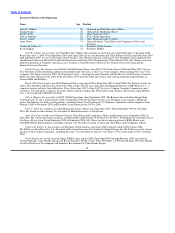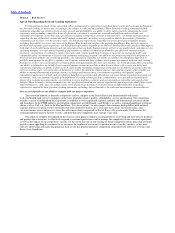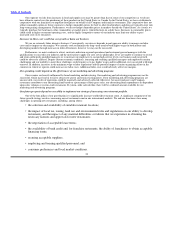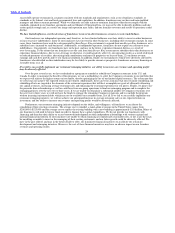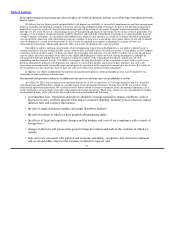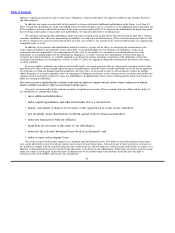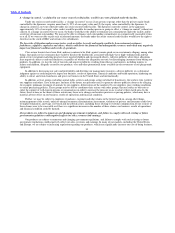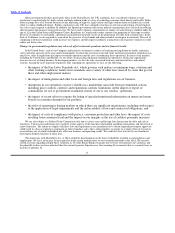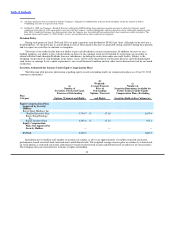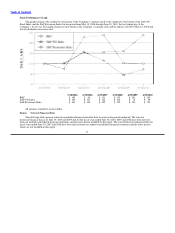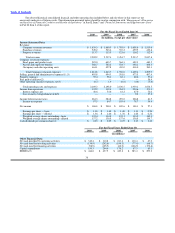Burger King 2010 Annual Report Download - page 30
Download and view the complete annual report
Please find page 30 of the 2010 Burger King annual report below. You can navigate through the pages in the report by either clicking on the pages listed below, or by using the keyword search tool below to find specific information within the annual report.
Table of Contents
restaurants in desirable locations. As a result, our sales and our brand building initiatives could be adversely affected.
We generally cannot cancel these leases; therefore, if an existing or future restaurant is not profitable, and we decide to close it, we
may nonetheless be committed to perform our obligations under the applicable lease including, among other things, paying the base rent
for the balance of the lease term.
We may not be able to adequately protect our intellectual property, which could harm the value of our brand and branded products
and adversely affect our business.
We depend in large part on our brand, which represents 32% of the total assets on our balance sheet as of June 30, 2010, and we
believe that our brand is very important to our success and our competitive position. We rely on a combination of trademarks,
copyrights, service marks, trade secrets and similar intellectual property rights to protect our brand and branded products. The success
of our business depends on our continued ability to use our existing trademarks and service marks in order to increase brand awareness
and further develop our branded products in both domestic and international markets. We have registered certain trademarks and have
other trademark registrations pending in the United States and foreign jurisdictions. Not all of the trademarks that we currently use have
been registered in all of the countries in which we do business, and they may never be registered in all of these countries. We may not
be able to adequately protect our trademarks, and our use of these trademarks may result in liability for trademark infringement,
trademark dilution or unfair competition. The steps we have taken to protect our intellectual property in the United States and in foreign
countries may not be adequate. In addition, the laws of some foreign countries do not protect intellectual property rights to the same
extent as the laws of the United States.
We may, from time to time, be required to institute litigation to enforce our trademarks or other intellectual property rights, or to
protect our trade secrets. Such litigation could result in substantial costs and diversion of resources and could negatively affect our
sales, profitability and prospects regardless of whether we are able to successfully enforce our rights.
Our indebtedness under our senior secured credit facility is substantial and could limit our ability to grow our business. In the event
we are unable to refinance or repay such indebtedness prior to their maturities, we may need to take certain actions which could
negatively impact our business or dilute our existing stockholders.
As of June 30, 2010, we had total indebtedness under our senior secured credit facility of $753.7 million, of which $87.5 million
was under Term Loan A and $666.2 million was under Term Loan B−1. The maturity dates of Term Loan A, Term Loan B−1 and any
future amounts borrowed under the revolving credit facility are June 30, 2011, June 30, 2012, and June 30, 2011, respectively. Our
indebtedness could have important consequences to you.
For example, it could:
• increase our vulnerability to general adverse economic and industry conditions;
• require us to dedicate a substantial portion of our cash flow from operations to payments on our
indebtedness if we do not maintain specified financial ratios, thereby reducing the availability of our cash
flow for other purposes;
• limit our ability to implement our growth strategy and strategic initiatives; or
• limit our flexibility in planning for, or reacting to, changes in our business and the industry in which we
operate, thereby placing us at a disadvantage compared to competitors that may have less indebtedness.
Our revolving credit facility provides for the issuance of letters of credit and, at June 30, 2010, we had $34.2 million of
irrevocable standby letters of credit outstanding under the revolving credit facility. The beneficiaries under these letters of credit
generally require expiration dates of one year. Since our revolving credit facility is scheduled to mature within one year, letter of credit
beneficiaries could require us to provide cash deposits to replace the standby letters of credit we issued under our revolving credit
facility. In such case, we would need to
28


